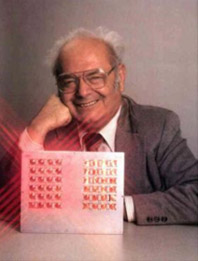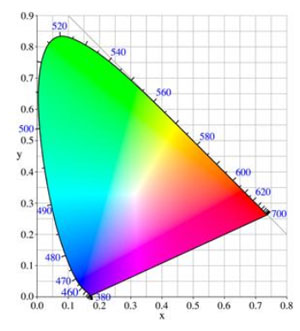

HP People Stories
Egon Loebner
 |
Egon with his LED display
|
Egon was another of the true geniuses who populated the HP Laboratories. He had joined HP in 1961, from RCA Advanced Laboratories at Princeton, NJ, as an expert on electro-luminescence. I got to know Egon, as my little product development group at HPA Division was beginning to develop light emitting diodes for numeric indicators.
There were so many process variables in those days, it was a wonder that we ever did produce semi-conductor diodes of Gallium-Arsenide-Phosphide (GaAsP), which would emit red light. Our manufacturing and design guys were always calling on experts in the HP Labs, such as Loebner, Bob Burmeister, Paul Green, and others who helped solve those nasty semiconductor processing problems.
Just one example; in processing GaAs wafers into diodes, there were something like 32 different process steps from start to the end, and the whole cycle took maybe a month. At one point, we bought ourselves a simple new mechanical thickness gage, which were used to slide new wafers under a probe, to measure thickness of approximately 0.010 inches. Except that someone forgot to throw away the new brass probing point, that came with the machine, and replace it with plastic.
It seems that just rubbing the brass probe across the wafer was enough to transfer copper atoms from the metal probe onto the wafer surface. Later, in the diffusion furnace, those few copper atoms diffused into the crystal lattice structure, just enough to kill the light. Worse, it took us a full month, and hundreds of wafers in production, to find out that entire batches were ruined. "Those were times that tried men's souls," and we often needed expert help.
Other than his profound technical contributions (There is a hard-bound book in HP's libraries, created in memory of Egon, which covers his lifetime of publications at HP. It is also available on Amazon.). Egon was a PROLIFIC writer, with dozens of professional papers to his credit. I remember Egon for two particularly personal events.
 |
Egon plotted political views of a group of fellow-students,
which mimicked this color chart |
1) Once, in an informal setting, Egon and I were discussing a particular graphic used in electro-optics, called the CIE (Commission Internationale De L'Eclairage) Chromaticity Diagram. In the optical business, it defines dominant wavelength and color purity. It shows every color of the visible spectrum, placed onto the chart. Egon mentioned that in his later college years, he had once postulated, that the different colors of light as shown in the graphic, might well be correlated with political viewpoints. So he undertook a simple college project to survey some hundred of his fellow students and professors, and plotted their political positions on a similar graph. It was surprising to me, but not to him, that his survey showed people's political spectrum was distributed very similar to the color spectrum.
To me, it showed his exquisite curiosity, and his cross-disciplinary approach to life.
2) In 1978, I was National President of the National Conference of Standards Laboratories as mentioned before. I was looking for a banquet speaker for our annual conference in Los Angeles. So, I got a commitment from Eberhardt Rechtin, who had served with Dave Packard at the U.S. Department of Defense, in the early 1970's. When Packard returned to HP in 1972, he convinced Rechtin to come with him. Rechtin had served previously with NASA, and was a technically brilliant and multi-faceted man with a charming speaking personality. I felt he fit the bill nicely for our banquet speech, which had technical people as well as spouses with only a shallow interest in our nation's technology.
About a month before the conference, Rechtin called and cautioned me that he probably would not be able to make his engagement. As it turned out, he had already been hired away from HP by the Aerospace Corp, a major program contractor for the U.S. Air Force in Los Angeles. So I scrambled to find a replacement speaker. Luckily, Egon had just returned from a 3-year tour as a government loaned executive, serving as a technical liaison officer at the U.S. State Department in Moscow. In that role, he had organized cross-liaison trips of hundreds of technical groups and committees who were travelling between the U.S. and Russia. Subject matter for those technical exchanges included everything from welding technology to space travel, as the two countries were beginning to open up their technical relations in a good way.
I felt that Egon's observations of the Russian technology of instrumentation and industry would be interesting and current and valuable to our metrology dinner guests. After his after-dinner speech with appropriate slides, during which he praised certain of the Russian technologies, the question and answer session deteriorated quickly. A "question" from a metrologist from Rockwell Corp., Anaheim, went on for about 5 minutes trying to refute Loebner's positions. The Master of Ceremonies asked the questioner to finish, and frame his question, but he insisted that he MUST REFUTE Loebner's positions. When several others in the audience rose to back the questioner, I, as president, took the microphone and ended the after-dinner meeting.
As the dinner broke up, the original questioner came up, and almost got in a fistfight with the Master of Ceremonies. I was flabbergasted by this turn of events. Egon just smiled.
Later, Egon and I flew home together from LAX. We had a drink in the lounge, while waiting for the flight. It was there that he showed me his forearm, which had the distinctive 5-digit serial number tattoo of the WWII Jewish concentration camp victims. It turned out that the dinner questioner had been a German U-boat commander during WWII, and that he had immigrated to the U.S. to join some of the Rockwell Corp teams, that were working on inertial guidance for inter-continental ballistic missiles.
As a naïve mid-westerner, I was extremely unknowledgeable of so many of those awful political and racial events of the WWII holocaust. Egon carefully informed me that many Germans could not conceive of any good technology, whatsoever, coming out of Slavic races like Russia or Poland. Poland was his country of birth. Then he proceeded to tell me of his narrow escape at the Auschwitz death camp.
It seems that by the time he got to the camp, someone realized that his engineering background could be put to use in the camp's facilities dept. It turned out that a major dysentery epidemic had just broken out, and since that river passed by Berlin, but way downstream from the death camp, there was a remote danger the camp's sewage germs might infect Berlin. The camp commander decreed that their sewage system must be brought to top form. So Egon got to design and specify equipment and pipes for the construction. He took great delight in telling me how he massively over-designed the pipes, such that he used up enough extra steel, that might have manufactured several Nazi tanks, a number I can no longer recall.
-- John Minck
